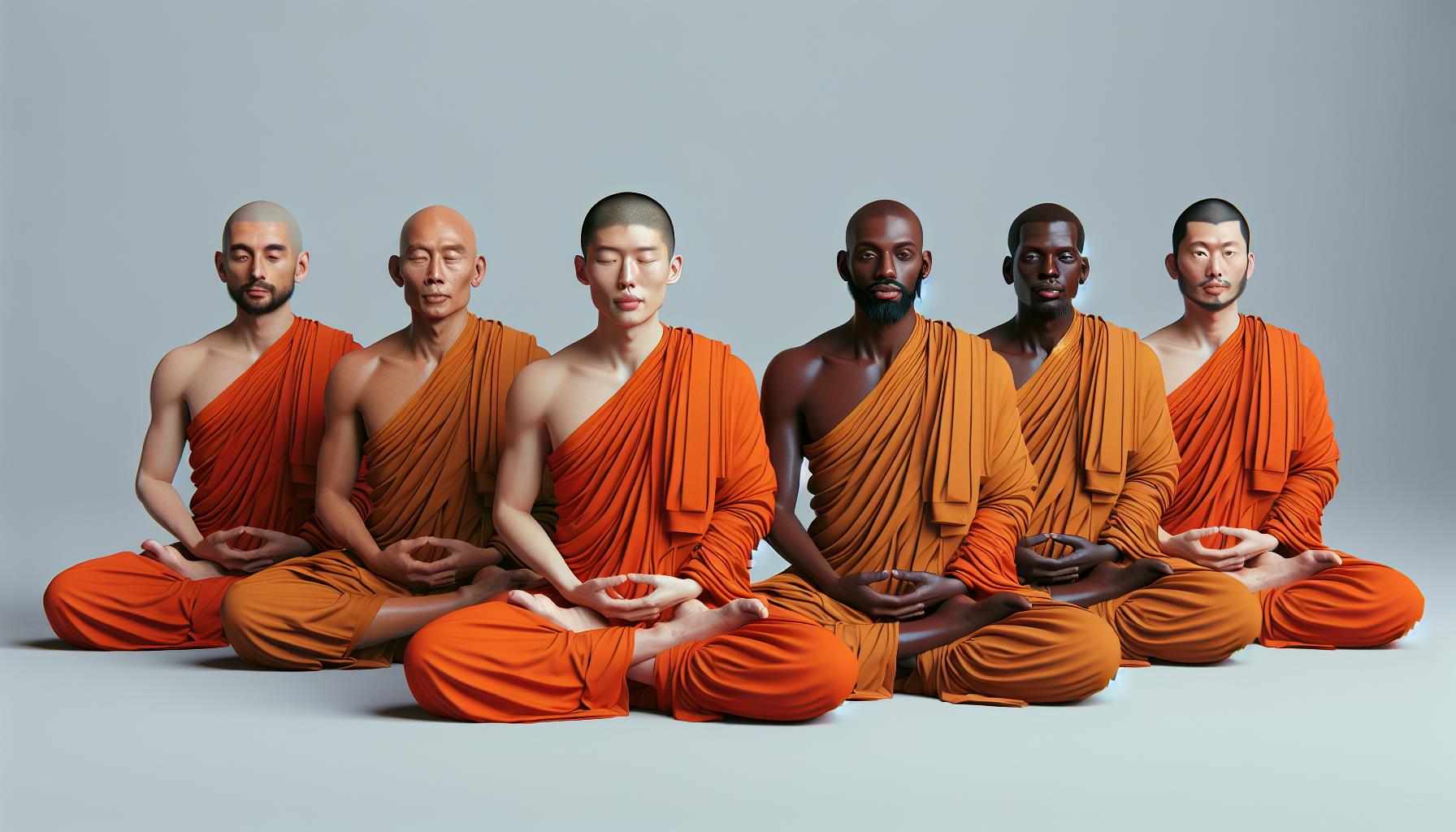Buddhist Chant Meditation: Enhance Insight and Resilience
Diving into the serene world of Buddhist chants can transform your meditation practice. These ancient rhythms and sounds are designed to soothe your mind and align your spirit with the vibrations of tranquility. Whether you’re a seasoned meditator or just starting out, integrating chants into your routine can elevate your experience to new heights.
You’ve likely heard about the power of mantra chanting in meditation, but what makes Buddhist chants uniquely potent? They’re not just tools for focus; they’re pathways to deeper insight and connection with the universe. Get ready to explore how these sacred sounds can unlock a profound inner peace and help you tap into a deeper level of consciousness.
The Power of Buddhist Chanting in Meditation
When you blend chanting with your meditation practice, something special happens. You’re not just sitting in silence; you’re engaging with a tradition that has supported countless individuals in their search for serenity and enlightenment. Buddhist chanting acts as an auditory guide, a steady rhythm that helps regulate your breath and steadies your mind.
Some people might think chanting is just about reciting words, but it’s so much more. With each chant, you’re tapping into centuries of wisdom. These phrases have been fine-tuned to resonate, not only through the air but within you. They work subtly, gradually aligning your thoughts with the rhythm until you find yourself in a profoundly peaceful state. You’re creating a personal connection to a practice that’s been a lifeline to many before you.
Think about it this way: meditation opens the door to inner calm, and chanting is the key that fits perfectly into the lock. It’s not a one-size-fits-all solution, but rather an adaptable tool that you can shape to meet the contours of your personal spiritual journey. By incorporating Buddhist chanting into your routine, you mold your meditation experience to be uniquely yours.
If you’re worried about doing it “right,” don’t be. It’s less about perfect pitch or faultless pronunciation and more about the intention and focus you bring to the practice. Your voice, whether strong or soft, contributes to an ancient echo that connects you to something larger than yourself.
Are there any specific chants to start with? Absolutely. Begin with something like Om Mani Padme Hum, a mantra known for its potency and said to contain all of Buddha’s teachings in just six syllables. This chant is about humility, patience, diligence, renunciation, and wisdom – themes that might resonate deeply with your meditation goals.
| Favorite Chants | Focus Points |
|---|---|
| Om Mani Padme Hum | Compassion & Wisdom |
| Gate Gate Paragate | Enlightenment & Liberation |
| Nam Myoho Renge Kyo | Devotion & Determination |
Understanding the Sacred Sounds of Buddhist Chants

When you delve into the power of Buddhist chants, you’re interacting with a tradition steeped in sacredness. These chants are more than just sequences of words. They’re portals to a deeper spiritual landscape that can transform your meditation experience.
Each chant is crafted from ancient texts, and the sounds themselves hold profound meanings. Sanskrit, Pali, and Tibetan are some of the languages these chants come from. Their sounds are designed to resonate with the energetic centers in the body, known as chakras, helping to align and balance your spiritual energy.
Chanting is also a way to honor the lineage of Buddhist teachers. As you speak or sing these phrases, you’re joining a river of voices that spans centuries. This act creates a powerful bond between you and the community of practitioners worldwide.
You might wonder how exactly these chants impact your mind. Well, studies suggest that rhythmic repetition of chant can have a neurological benefit. It activates areas of the brain associated with relaxation and well-being. You’re not just relaxing your body; you’re actively rewiring your brain to manage stress better.
Here’s a quick glance at how this works:
- Chant repetition can lead to the downregulation of the amygdala which is responsible for the fight or flight response
- It encourages theta wave production in your brain associated with deep meditative and peaceful states
- Chanting contributes to the increase of the happiness hormone serotonin
To get started, you may want to familiarize yourself with some foundational chants. “Om Mani Padme Hum” is a classic choice that is both accessible for beginners and deeply revered. Its syllables are believed to carry the essence of the Buddhist teachings, focusing on compassion and purification.
Keep in mind that the practice of chanting is flexible. You can chant quietly or loudly, alone or with a group, and virtually anywhere you find peace. Over time, as you build your practice, you’ll naturally gravitate towards chants that resonate with you personally. These moments of connection mark the beginning of a deeply personal journey into the heart of Buddhist meditation.
The Benefits of Integrating Chants into Your Meditation Practice

Introducing Buddhist chants into your meditation isn’t just a way to mix things up; it’s a method backed by centuries of tradition. It’s a simple yet impactful technique that can lead to a variety of mental and emotional improvements.
Mindfulness becomes more accessible when you chant. The rhythmic nature of chanting can help you stay focused and present. As you repeat the words, your mind is less likely to wander, which means you’re keeping distractions at bay. Over time, you might find your concentration skills sharpening, even outside of your meditation sessions.
Your breathing can get better too. Chants naturally regulate your breath, making it deep and even. This type of breathing calms the nervous system, which in turn can lower your heart rate and blood pressure. These changes are not only good for your meditation—they’re excellent for your health overall.
Let’s talk about community as well. If you’ve ever chanted in a group, you know there’s an undeniable sense of connection that forms. This isn’t just a feeling; it’s the vibrations of your collective voices creating a shared energetic space. You’re not just repeating words; you’re part of a living, breathing tapestry of people who are seeking the same sense of peace.
Chanting’s positive effects extend beyond the spiritual. Research shows that these practices can tip the scales in favor of your emotional well-being. Regular chanting has been associated with reduced levels of stress and anxiety. It also has the potential to increase feelings of joy and tranquility.
Integrating chants into your meditation could be the shift you’ve been looking for. Whether you’re seeking deeper concentration or a stronger sense of community, the traditional practice of chanting is likely to support your journey in a myriad of beneficial ways.
How Buddhist Chants Can Enhance Your Inner Peace

Harnessing the power of Buddhist chants in your meditation routine could be a game-changer for your personal tranquility. Picture yourself enveloped in the rhythmic cadence of ancient sounds; it’s like a sonic embrace that smooths away the chaos of the day.
Chanting is an anchor, a steadfast fixture in the turbulent ocean of your thoughts. When you chant, you’re giving your brain something to hold onto. You’re not just sitting there with your mind wandering to your grocery list or that email you forgot to send. You’re reciting, listening, and being fully in the moment—which is what meditation’s all about, isn’t it?
As you’re likely aware, stress isn’t just a mental game—it’s physical, too. Your body reacts to stress in ways that aren’t always visible. But when you incorporate chants into your practice, you’re essentially telling your body, “Hey, it’s time to chill out.” Your breathing evens out, and your stress levels start to drop. That’s the power of chanting for you.
Let’s break this down:
- Repetition of chants can be amazingly soothing; it’s like a mental massage for the brain.
- As your breathing aligns with the rhythm, a natural relaxation response kicks in.
- The collective vibe of group chanting is like a support system for your soul, elevating the whole experience.
Don’t you also find that melodies have a way of lingering in the mind? With Buddhist chants, these spiritual earworms can continue to work their calming magic long after your meditation session has ended, keeping a tide of peace rolling through your daily life.
Imagine the difference you’d feel embracing this practice: fewer knots in your stomach, a quieter mind, and a serenity that can weather life’s storms. As you continue to journey through various meditation practices, consider how seamlessly Buddhist chants might weave into the fabric of your self-care routine.
Unlocking Deeper Insight and Connection through Chanting

When you immerse yourself in the rhythmic flow of Buddhist chanting, you’re tapping into something much more profound than the act of vocalizing words. Chanting is a bridge to unlocking deeper realms of consciousness and fostering a strong connection with the universe itself. You’re not just reciting texts; you’re participating in an age-old practice that monks have long found to lead to greater wisdom and understanding.
The repetitive nature of chanting can be likened to the strokes of a painter on a canvas—each one contributes to a larger picture of mindfulness. It’s during these moments that your heart and mind sync, and brilliant insights might just bubble to the surface unannounced. As you chant, the barriers between the inner self and the outer world begin to dissolve, creating room for a sense of oneness that stretches beyond the physical space you occupy.
Group chanting only amplifies these effects. When voices unite in a chant, it creates a powerful vibrational energy that resonates within each participant. Shared intentions and collective focus work in harmony, delivering a sense of connection that’s tangible. You’re no longer a solitary figure on your meditation cushion; you’re part of something greater—a community that’s seeking peace and insight together.
And let’s not forget the neurological perks of chanting. With every melodious repetition, your brain is firing and forging new pathways. These aren’t just temporary patterns; with regular practice, chanting can lead to long-term changes in your brain structure, further enhancing your capacity for insight and emotional resilience.
Buddhist chants carry within them the power to remodel your practice and life. As you explore the mantras and their meanings, you may begin to notice a shift in your perception. Your meditation becomes more than a pause in your day—it’s a profound engagement with the deepest parts of your being. Each session is a step toward spiritual clarity, and the more you chant, the more attuned you’ll become to the subtle messages whispered from within.
Conclusion
Embrace the transformative power of Buddhist chanting in your meditation practice and you’ll tap into a wellspring of spiritual and neurological benefits. As you chant, you’re not just reciting words; you’re building bridges to wisdom and fostering an intimate bond with the cosmos. Remember, the vibrational energy you create, especially in a group, can elevate your consciousness to new heights. Let these ancient chants guide you to profound insights and emotional resilience. Start your journey today and watch as your inner clarity flourishes with every chant.







